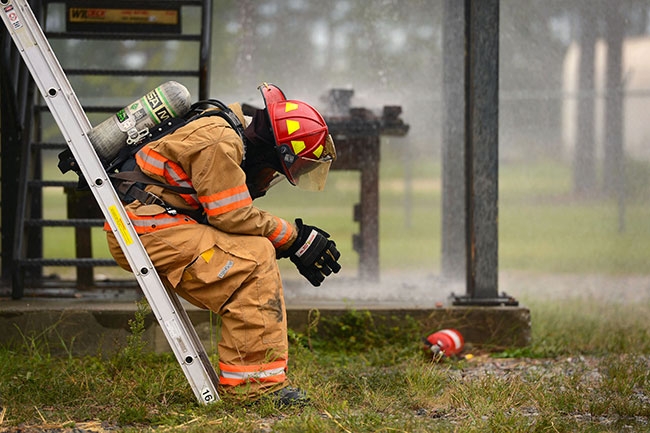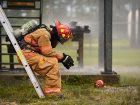
Features
Health and wellness
Hot topics
Building resilience: Core principles to overcoming PTSD
Firefighter David Gillis never knows when a response to a call will trigger the symptoms of post-traumatic stress disorder (PTSD). But through a program called Strategic Resilience for First Responders, Gillis is able to manage the mental and physical reactions that used to stop him in his tracks.
May 24, 2017
By David Gillis and Ruth Lamb
 First reponders are twice as likely as other people to develop PTSD Like a sturdy structure
First reponders are twice as likely as other people to develop PTSD Like a sturdy structureResilience can be learned over time, according to program creator Ruth Lamb, a faculty member at Langara College in Vancouver.
Lamb is a former critical care nurse who experienced her own challenges as a first responder; she left critical care after 10 years, using more than 15 years of on-the-job experience working in and researching high-trauma settings to develop a program that addresses PTSD holistically.
Gillis, a volunteer firefighter in Squamish, B.C., with more than a decade in the service, now applies his resilience training at every call.
Since 2015, the program has expanded: The University of New Brunswick licensed the program in 2016 and a similar program will begins this month in the Nova Scotia Community College system.
Lamb and Gillis originally wrote about the program in March 2016 (go to www.firefightingincanada.com and click Hot topics / health and wellness).
■ Gillis
In January I attended a call that I felt was a terrible and tragic loss of life. I understood the possibility of exposing myself to yet another traumatic situation.
The call originally came in as a rubbish fire. The report said it was just off the highway, in the bush, with no structure or exposure issues. It was late on a Saturday evening, almost midnight. It was a relatively routine call, until further updates came in. There was a tent, which was still burning, with someone inside.
The fire must have been quick and intense, possibly fuelled by propane from what appeared to be a small camping stove. When we got on scene the fire was mostly out and everything within the tent area was completely burned and or melted. Everything.
We returned to the hall, put the apparatus back into service and had a short discussion about how each of was doing before heading back home. We tried to reconnect and reset our nervous systems.
I knew that some of what I experienced that evening had the potential to trigger past trauma, but as I drove back home I already felt something was different; I didn’t feel jacked-up, as I had after previous traumatic incidents. There was no residual adrenaline, no twitching, no feeling irritated or anxious, no haunting thoughts or startling images about the call.
■ Lamb
In Gillis’ early processing of this event, there is evidence that he made a conscious effort to be present. This is the initial step when providing first-aid care for trauma; in the field, it is called strategic effective enduring resilience (SEER) protocol. The following five core practices keep first responders focused on the present moment, instead of a traumatic past: breathing, grounding, centering, aligning and resourcing.
Ideally, one should implement these practices daily. This way, the practices create habitual brain pathways, like muscle memory.
- Breathing impacts our physiology and psychology. Step one is to observe your breath – and pay attention to your breath from one moment to the next. Is it ragged and short? Are you hardly breathing at all? By paying attention to your breath, you will be able to make a conscious effort to slow down and breathe deeper. In times of stress, taking an in-breath and letting the out-breath extend is a good way to activate the parasympathetic nervous system (PNS). This aspect of the nervous system helps regulate your response to trauma and activates the body’s powerful natural healing responses.
- Grounding refers to being aware of the five senses. To ground ourselves, we must pay attention to the feelings and sensations of our physical bodies. For example, actually feeling your feet on the ground or the breeze on your face. We need to remain present with ourselves, and the individuals we assist on every call – be there with them, while also being cognizant of the environment and yourself. Take the time to respond to your body’s own cues.
- Centering is the ability to acknowledge how we feel in the moment. Being aware of your present emotional state allows you to access internal resources. To reach in to this deeper state, it is necessary to pair the logical and analytical left-side brain with the creative right-side brain. When we can regulate our breathing and be present through grounding practices, we can be still enough to allow this centered state to unfold. And amazingly, this state helps us recalibrate a nervous system that has made a habit of stacking trauma upon trauma, call after call.
- Aligning oneself naturally follows when these SEER practices are utilized. Through these exercises, first responders build momentum towards a balanced nervous system, better emotional regulation, and a stronger sense of self. What is more, this authentic self-awareness helps us develop greater ability to read a situation or others emotions; thereby we are more effective when it comes to prevention and de-escalation.
- Resourcing refers to our ability to access our inner and outer resources. These are unique to every individual, so it is important to know what your resource are and how to use them. For example, inner resources could be these five practices and other skills we have developed to support our mental wellbeing. Outer resources could include our co-workers, family and friends, or even nature.
Working through these five wellness practices regularly makes it much easier for responders to cope with stressful experiences.
■ Gillis
A critical incident stress debrief (CISD) session had been arranged two days after the call, but at that time, I felt that I needed to go back to the site to try and clarify the call for myself before the debriefing. I’ve never done this before; I just had a deep inner feeling that I needed to revisit the scene.
Once back on scene, I could picture the charred body among the debris (which had been removed), while remaining aware of my surroundings and of myself. I was there in that moment, not the moment of the incident. I expected to be triggered and have feelings of sorrow, grief or sadness, but that didn’t happen. I stayed connected to my surroundings: the ground beneath my feet, the evergreens and alders, the cool breeze and the smell of the forest.
■ Lamb
Gillis is forming a mental-wellness strategy that utilizes these resilience-based practices. This is as vital as any technical procedures first responders use to protect the lives of others. Activating our inner and outer resources can lead to major changes in thinking. Resilience comes from a finely tuned, balanced and co-ordinated brain. When individuals breathe deeply, ground through the body, acknowledge emotions, observe thoughts and identify healthy habits that support wellbeing, they can begin to build healthier bodies and brains.
■ Gillis
In the past I would ruminate over previous traumas and worry about ones that haven’t happened yet. This simply took me out of the here and now, where life really takes place. My journey of healing and recovery from PTSD has been long and slow, but the process seems to have sped up when I began to focus on living fully in the present.
I am thankful to everyone who has been supportive and understanding throughout my journey. My support system has helped me maintain a sense of worth and connection, as I continue to contribute to the community as a firefighter and first responder, a husband, a parent and a grandparent.
■ Lamb
Resilience-based practices allow us to recalibrate physically, mentally and emotionally after critical incidents, as a critical incident impacts the whole body on every level. Start these practices early, as soon as possible after the incident, perhaps even in small ways during an incident. This will make a difference. Then we can use long-term rebalancing strategies to override trauma-related patterns etched into our lives from the inside out, from the nervous and immune systems to jobs and relationships. If first responders do not take the time to learn resilience-based practises, they could face with impaired integration of the brain and body. When trauma takes hold, chaos, confusion and rigidity overtake the mind. The above SEER practices can be used to combat trauma-related reactions in first responders, allowing them to gain new levels of self-mastery. It takes time, but just look at what Gillis has been able to accomplish. He is now training recruits and is an instructor in the strategic resilience program for first responders at Langara College.
David Gillis, is a volunteer lieutenant and first responder in Squamish, B.C. Contact him at davidgillis2@gmail.com
Ruth Lamb RN, MSN, PhD, is a registered nurse and the program co-ordinator, health and human services at Langara College. Contact her at rlamb@langara.ca
Print this page
Advertisement
- Stopbad June 2017: Avoid bad calls with better training
- NFPA Impact June 2017: Sprinkler stipend program comes to Canada

